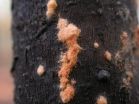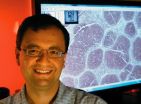(Press-News.org) Berkeley – In a demonstration of "reverse-ecology," biologists at the University of California, Berkeley, have shown that one can determine an organism's adaptive traits by looking first at its genome and checking for variations across a population.
The study, to be published the week of Jan. 31 in the journal Proceedings of the National Academy of Sciences, offers a powerful new tool in evolutionary genetics research, one that could be used to help monitor the effects of climate change and habitat destruction.
The researchers scanned the genes of 48 different strains of Neurospora crassa, a type of red bread mold commonly used in genetics research. It is considered a model microbe because different strains can be mated and grown very quickly, and its growth occurs in a light-sensitive daily cycle that has been useful for studying circadian rhythms.
Yet for all its popularity in the lab, little was known about this fungus in its natural habitat, so the researchers specifically chose wild samples of the microbe from the Caribbean basin, South America and Africa. From this population-wide analysis, they found a striking pattern of variation in two regions of the genome that indicated the action of natural selection.
Within one of these regions, they found a gene that is known to be important to survival at cold temperatures, and posited that genes in the other region might play the same role. They then showed that members of the population that contained unique variants of their candidate cold-tolerant genes lived in regions with lower minimum temperatures – up to 9 degrees Celsius – on average and were able to grow better at cold temperatures than were strains found in more tropical climates.
The researchers also grew wild strains of Neurospora crassa in the lab alongside strains where the candidate cold-tolerant genes had been deleted from the genome, keeping all things the same except for the temperature. They confirmed that the strains with the genes for cold tolerance disabled fared more poorly in chillier temperatures.
"This is the first time that population genomics has been used to find genes important for adaptation without any idea of the environmental parameters, phenotype, candidate genes or even the population boundaries," said the study's principal investigator, John Taylor, UC Berkeley professor of plant and microbial biology.
Taylor pointed out that the normal route for adaptation studies is to first look at obvious differences – such as hair or skin color – between two closely related organisms. Scientists next observe the environment in which the organism lives to see if it might explain those differences, and then examine the genes to see if there is evidence of natural selection.
For example, the researchers referred to a 2003 study noting that rock pocket mice with tan-colored fur are often found among light-colored rocks, while those with black fur were found on dark lava flows. They identified the genetic basis of this adaptive trait by targeting genes for further study that were known to be involved in pigmentation and showed that different gene variants were associated with the different habitats.
"For our study, we turned this around, beginning with genes that showed evidence of selection, and then looking at the environmental factors that might influence those genes," said Taylor.
This "reverse-adaptation" approach is especially useful when studying microbes, the researchers argued.
"Microbes are inconspicuous by nature and, unlike mice which can have different colored coats, different strains and species look pretty much the same," said study lead author Christopher Ellison, a UC Berkeley graduate student in plant and microbial biology.
As if to demonstrate this point, the researchers discovered that what had been considered a single group of interrelated strains was instead two distinct populations.
The relative ease of studying a microbe such as Neurospora crassa in the lab may make it an appealing tool to monitor the impact of environmental stress, the researchers said.
"If temperature is a key adaptive factor in populations of fungi and microbes in general, this could have important implications in the study of climate change," said Ellison. "Adaptation is a crucial part of evolution, so microbes could be used to monitor global temperature change."
INFORMATION:
Other UC Berkeley co-authors of the study are Rachel Brem, professor of molecular and cell biology; N. Louise Glass, professor of plant and microbial biology; and members of the Glass Lab – Charles Hall, post-doctoral researcher, and staff researchers David Kowbel and Juliet Welch.
The National Institute of General Medical Sciences helped support this research.
Analysis of bread mold genomes demos 'reverse-ecology' tool
2011-02-01
ELSE PRESS RELEASES FROM THIS DATE:
Hunt for dark matter closes in at Large Hadron Collider
2011-02-01
The scientists have now carried out the first full run of experiments that smash protons together at almost the speed of light. When these sub-atomic particles collide at the heart of the CMS detector, the resultant energies and densities are similar to those that were present in the first instants of the Universe, immediately after the Big Bang some 13.7 billion years ago. The unique conditions created by these collisions can lead to the production of new particles that would have existed in those early instants and have since disappeared.
The researchers say they are ...
Scientists synthesize long-sought-after anticancer agent
2011-02-01
New Haven, Conn.—A team of Yale University scientists has synthesized for the first time a chemical compound called lomaiviticin aglycon, leading to the development of a new class of molecules that appear to target and destroy cancer stem cells.
Chemists worldwide have been interested in lomaiviticin's potential anticancer properties since its discovery in 2001. But so far, they have been unable to obtain significant quantities of the compound, which is produced by a rare marine bacterium that cannot be easily coaxed into creating the molecule. For the past decade, different ...
Researchers discover signaling pathway crucial to acute lung injury
2011-02-01
Researchers at National Jewish Health have discovered a signaling pathway that is crucial to the devastating effects of acute lung injury (ALI). The data, obtained from cells, animals and ALI patients, suggest several potential therapeutic targets. Experimental blockade of one of the targets significantly reduced flooding of the lungs that is the hallmark of ALI.
"Acute lung injury is a devastating disease, with 40 percent mortality and no beneficial therapies," said first author James Finigan, MD, Assistant Professor of Medicine at National Jewish Health. "Our study ...
Songbird's strategy for changing its tune could inform rehab efforts
2011-02-01
It takes songbirds and baseball pitchers thousands of repetitions – a choreography of many muscle movements -- to develop an irresistible trill or a killer slider. Now, scientists have discovered that the male Bengalese finch uses a simple mental computation and an uncanny memory to create its near-perfect mate-catching melody -- a finding that could have implications for rehabilitating people with neuromuscular diseases and injuries.
Young male Bengalese finches practice their boisterous mating song hundreds of times a day, comparing their melody to the songs of their ...
Novel immune system-based gene therapy induces strong responses in metastatic melanoma, sarcoma
2011-02-01
Researchers have found that a novel form of personalized therapy that genetically engineers a patient's own anti-tumor immune cells to fight tumors could treat metastatic melanoma and metastatic synovial cell sarcoma, representing a potentially new therapeutic approach against these and other cancers.
The technique, called adoptive immunotherapy, works with the body's immune system to fight cancer. Immune cells, called T lymphocytes, are removed, modified, expanded in large numbers, and given back to the patient. In this case, the process entailed genetically engineering ...
Computer-assisted diagnosis tools to aid pathologists
2011-02-01
Researchers are leveraging Ohio Supercomputer Center resources to develop computer-assisted diagnosis tools that will provide pathologists grading Follicular Lymphoma samples with quicker, more consistently accurate diagnoses.
"The advent of digital whole-slide scanners in recent years has spurred a revolution in imaging technology for histopathology," according to Metin N. Gurcan, Ph.D., an associate professor of Biomedical Informatics at The Ohio State University Medical Center. "The large multi-gigapixel images produced by these scanners contain a wealth of information ...
Explosive- and drug-sniffing dog performance is affected by their handlers' beliefs
2011-02-01
Drug- and explosives-sniffing dog/handler teams' performance is affected by human handlers' beliefs, possibly in response to subtle, unintentional handler cues, a study by researchers at UC Davis has found.
The study, published in the January issue of the journal Animal Cognition, found that detection-dog/handler teams erroneously "alerted," or identified a scent, when there was no scent present more than 200 times — particularly when the handler believed that there was scent present.
"It isn't just about how sensitive a dog's nose is or how well-trained a dog is. There ...
NASA sees large Tropical Cyclone Yasi headed toward Queensland, Australia
2011-02-01
Tropical Storm Anthony made landfall in Queensland, Australia this past weekend, and now the residents are watching a larger, more powerful cyclone headed their way. NASA's Terra satellite captured a visible image of the large Tropical Cyclone Yasi late yesterday as it makes its way west through the Coral Sea toward Queensland.
The Moderate Resolution Imaging Spectroradiometer (MODIS) instrument that flies aboard NASA's Terra satellite captured an image of Cyclone Yasi on Jan. 30 at 23:20 UTC (6:20 p.m. EST/09:20 a.m., Monday, January 31 in Australia/Brisbane local time). ...
Tracking the origins of speedy space particles
2011-02-01
NASA's Time History of Events and Macroscale Interaction during Substorms (THEMIS) spacecraft combined with computer models have helped track the origin of the energetic particles in Earth's magnetic atmosphere that appear during a kind of space weather called a substorm. Understanding the source of such particles and how they are shuttled through Earth's atmosphere is crucial to better understanding the Sun's complex space weather system and thus protect satellites or even humans in space.
The results show that these speedy electrons gain extra energy from changing magnetic ...
UCSB physicists challenge classical world with quantum-mechanical implementation of 'shell game'
2011-02-01
(Santa Barbara, Calif.) –– Inspired by the popular confidence trick known as "shell game," researchers at UC Santa Barbara have demonstrated the ability to hide and shuffle "quantum-mechanical peas" –– microwave single photons –– under and between three microwave resonators, or "quantized shells."
In a paper published in the Jan. 30 issue of the journal Nature Physics, UCSB researchers show the first demonstration of the coherent control of a multi-resonator architecture. This topic has been a holy grail among physicists studying photons at the quantum-mechanical level ...



